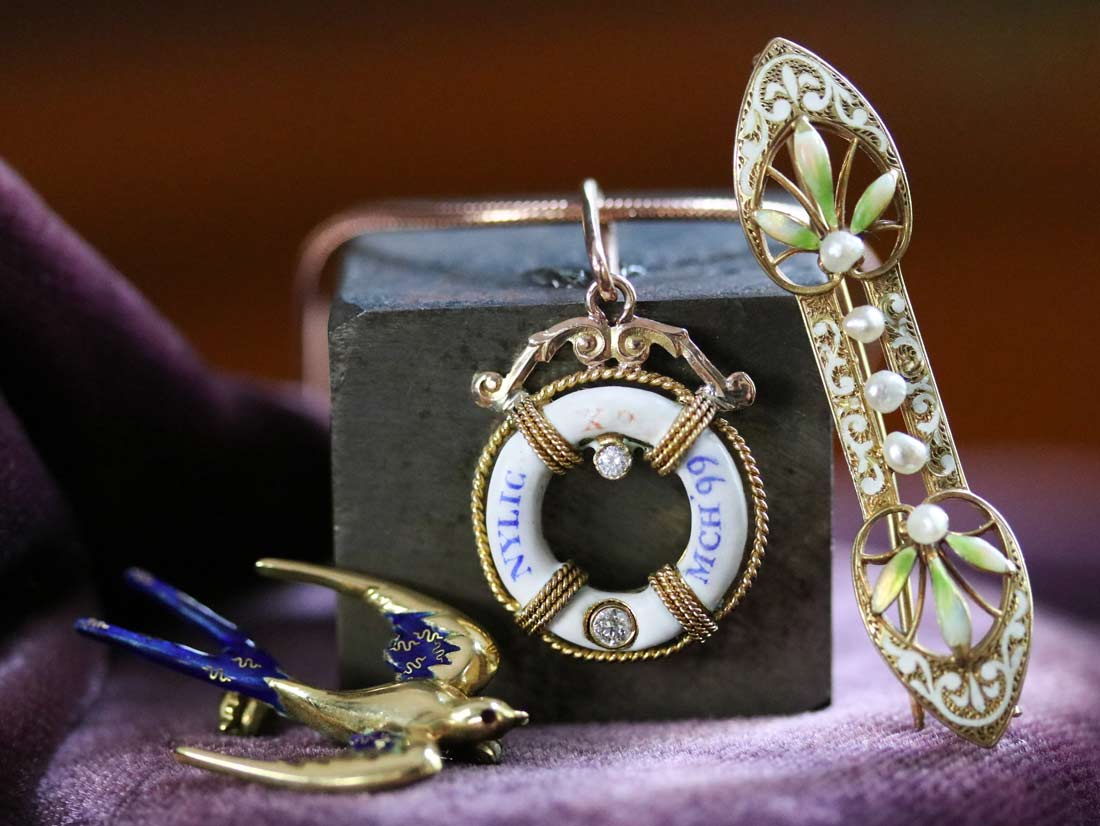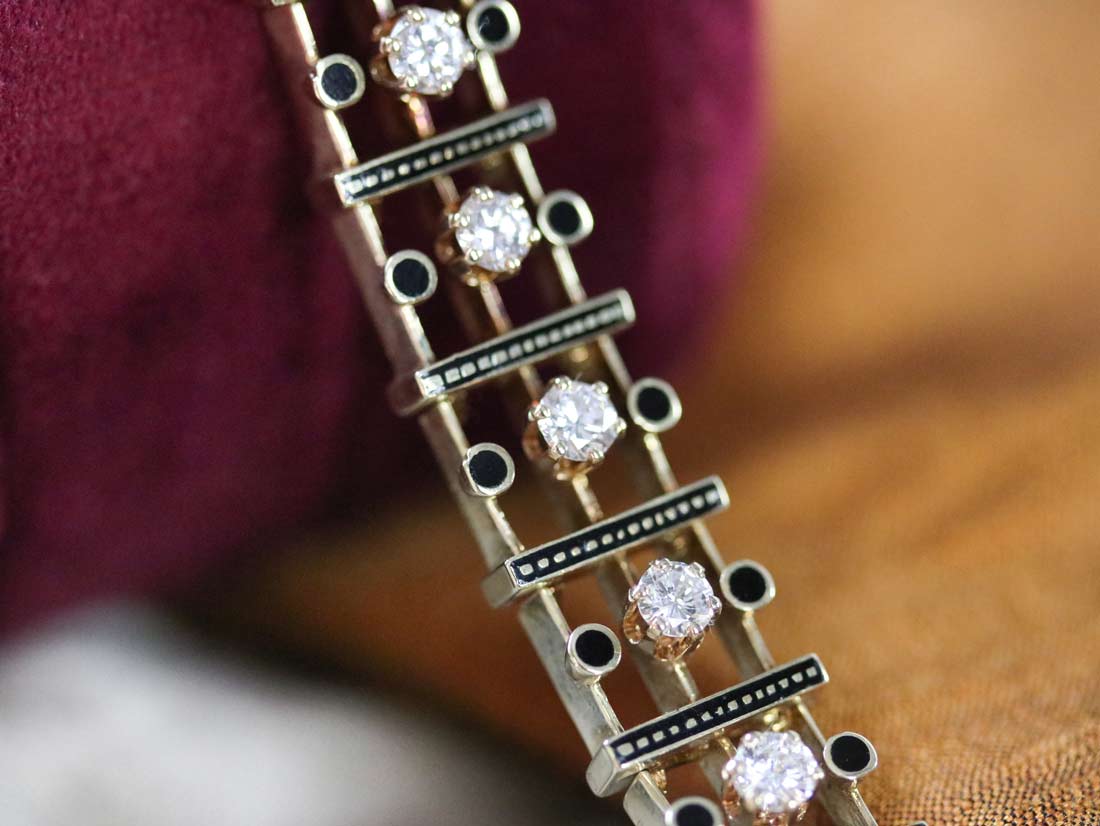GET 10% OFF! USE CODE YEAREND25 AT CHECKOUT
GET 10% OFF! USE CODE YEAREND25 AT CHECKOUT
Add description, images, menus and links to your mega menu
A column with no settings can be used as a spacer
Link to your collections, sales and even external links
Add up to five columns
Add description, images, menus and links to your mega menu
A column with no settings can be used as a spacer
Link to your collections, sales and even external links
Add up to five columns
The History of Enamel Jewelry
August 22, 2019 4 min read

Enamel jewelry has been around since the 13th century B.C.E. Since then, it has evolved and branched out, going in and out of fashion as jewelry trends changed. Enamel jewelry bridges the gap between fine art and jewelry design, blending elements of painting, chemistry, and metallurgy. Transcending cultures, time periods, and styles, enameling is an art form with an impressive endurance.
The Process of Enameling
Though there are many variations of enameling, the overall principle is the same. The process starts with a glass compound typically consisting of quartz sand, iron oxide, potassium oxide, and borax, which together are colorless. Various metal oxides and chlorides are then added to create different colors. Enamel can range from opaque to transparent. The compound is mixed, crushed, and washed until it is blended into something called a fondant. The fondant is applied to a pristine metal and allowed to dry. The piece is then heated to a precise temperature until the enamel melts and fills the space it's in, becoming shiny. The piece is taken out to cool, and then polished with a carborundum file.
Types of Enamel
There are many types of enamel techniques, but some have made their mark in the evolution of enamel jewelry. Here are several types of enamel and when they were invented:
Cloisonné Enamel (13th century BCE)
This is a technique involving laying flattened wires on to a metal base to create a design. The individual spaces formed by the wires are filled with the enamel fondant and fired. If silver or copper wires are used, they are gilded at this point.
Champlevé Enamel (12th century)
In this process, the metal base is carved into, etched, or struck to form channels and compartments that are filled with enamel. A similar technique called basse-taille (13th century) involves etching at different depths to change the transparencies of the enamel (deeper compartments had more enamel and thus were more opaque) and create a three-dimensional effect.
Ronde Bosse (15th century)
This is a method of enameling three-dimensionally, in which an adhesive gum is applied to the metal to help the fondant stick. When the piece is heated, the gum disappears while the fondant enamel fuses to the metal.
Painted Enamel (late 15th century)
In this process, a single color of fondant on a metal base is fired to form a background on to which a picture is hand painted. With each color that is painted on, the piece is fired to fix that layer. The colors are painted in order of their melting points, starting with the hottest temperature, to prevent the colors from blending together. A similar technique called grisaille uses grayscale colors painted on to a white background.
Enamel Photography (19th century)
This technique essentially involves coating the enamel with a light sensitive solution, covering with a photo negative, and exposing it to light. Then the enamel is coated with a black ceramic dust, which only sticks to the exposed areas, and fired.
Pertabghar (19th century)
This type of enamel was practiced in India and involves applying thick, green enamel on to a gold background, and then pressing an openwork gold design into the molten enamel.
Guilloché Enamel (late 19th century)
Guilloché is a technique that involves engraving a detailed symmetrical pattern on metal (done by machine). A translucent enamel can be applied on top, allowing the pattern to show through.
Plique-à-jour (early 20th century)
This technique involves creating designs with wires on to a thin sheet of mica or metal (which can be removed after firing) and filling with enamel. After the backings are removed, the effect is similar to stained glass.

Enameling Through the Centuries
What is believed to be the earliest known examples of enamel jewelry were found in Cyprus and date between the 13th and 11th centuries B.C.E. These included gold finger rings with enamel inlay. However, the first notable period where enamel jewelry flourished wasn't until the Byzantium era starting in the 3rd century C.E. Cloisonné enamel jewelry was predominant at this time, not only in the Eastern Roman Empire, but also in the Celtic regions of Gaul and Britain. The Celts, who also used basse-taille and champlevé enameling techniques, would adorn their battle equipment with enamel designs.
In the 12th century, Limoges, France became an important center for enamel design. Starting with champlevé techniques, they evolved the art form to basse-taille, eventually settling on painted enamel, for which they became renowned.
By the time the Renaissance period emerged in the 14th century, enameling was well practiced throughout Europe, and new techniques, such as ronde bosse enameling were invented. Enameling was mainly used on religious objects, and would eventually fall out of fashion by the 18th century.
Meanwhile, during the Mughal Empire in India and Pakistan of the 16th and 17th centuries, artists were crafting ornate jewelry with enamel details on both the front and back of the pieces. Indian jewelry makers would continue to innovate with different enameling techniques, including pertabghar enameling around 1870.
Another important period in the history of enamel jewelry would come in the 19th century. Inspired by the influence of newly imported Japanese art and objects, jewelry artisans used cloisonné enamel to mimic the flat plains of color and elegant line work of woodblock prints. The Victorians used black enamel on both mourning jewelry and everyday pieces for a gothic flair. When the Art Nouveau period emerged in the later part of the century, enamel was a frequently used design element in the nature-inspired jewelry of the time, particularly plique-à-jour enamel.
By the 20th century, mass manufacturing took the place of the handmade techniques of jewelry artisans. Later on, in the feminine and color-embracing Post-War period, enamel would re-emerge as a design element in jewelry.

What to Look For in Enamel Jewelry
If you are interested in starting an enamel jewelry collection of your own, look for pieces in which the enamel is in good condition, free of chips or cracks. The enamel should enhance the design of the piece, whether by adding color, contrast, or texture. Jewelry from the Art Nouveau era has some of the most beautiful uses of enamel, so it's a great place to start for any collector. Shop our collection of Art Nouveau jewelry here.
Also in MSJ Handbook

The Apple of Our Eye: Jade
May 29, 2025 3 min read
This powerful, ancient gemstone is still a treasure today.

Chrysoprase: The Golden Green Gem
September 17, 2021 2 min read
Subscribe
Get 10% off your next purchase!


